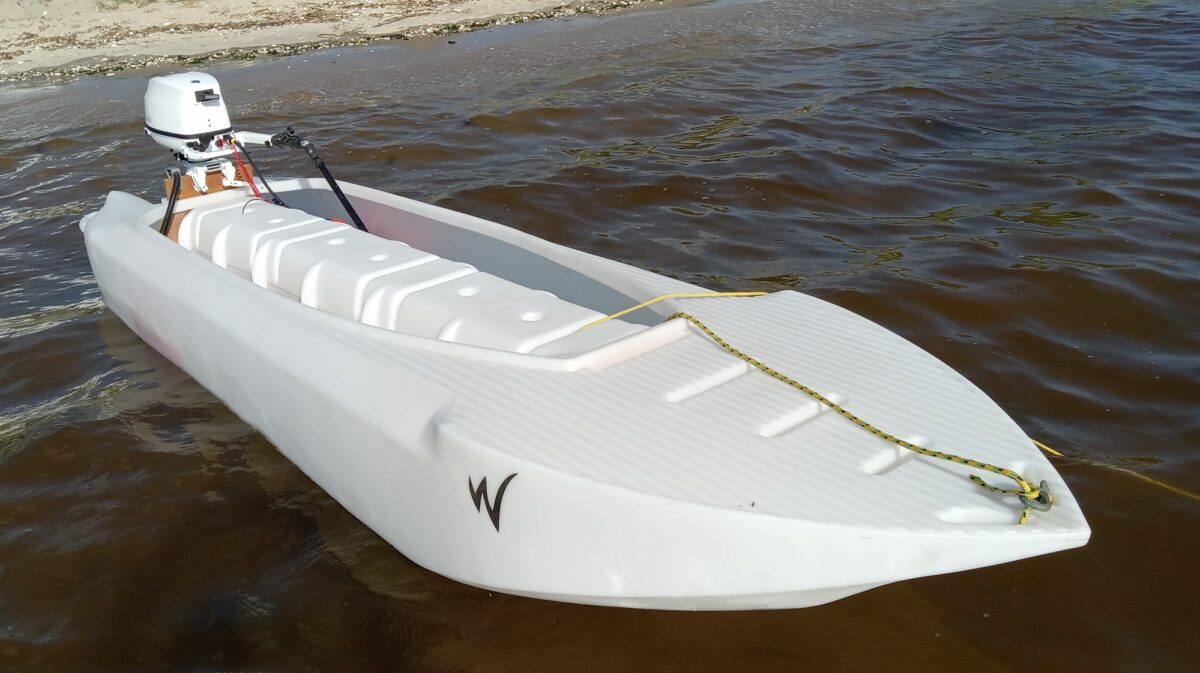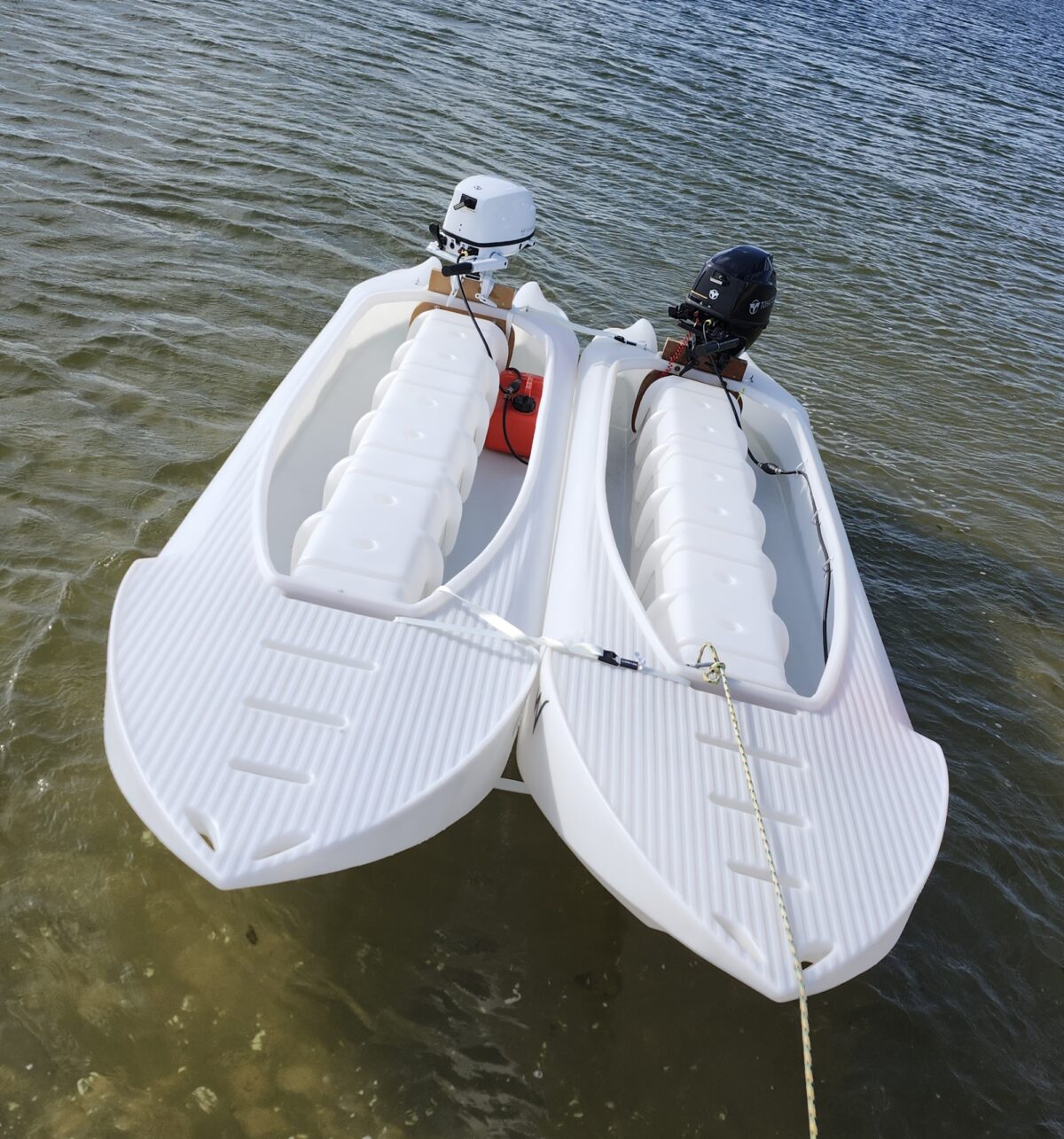Wavewalk’s new S4 Duo microskiff signals a paradigm shift in the small-boat market, namely Jon boats, microskiffs, and yacht tenders. It introduces both Portability and Versatility into the popular mainstream category of small boats for 1-6 passengers, and by doing so it makes these boats more useful, as well as easier and more fun to use.
Captain Larry Jarboe experimented with attaching together two and more Wavewalk boats, including the W700 kayak and the S4 Microskiff. He went as far as attaching three S4s together and host a dolphin-watching party with half a dozen passengers on board his ad hoc multi-craft.
In the years following these experiments, Wavewalk tested a few boats made from two S4 Microskiffs attached together, with crossbars and without them, and these experiments yielded the revolutionary S4 Duo.
A revolution in small boats?
Indeed it is, since the S4 Duo solved multiple problems that owners and users of small boats have been struggling with for many years.
Problems Solved –
- Comfort in Choppy Water and Increased Seaworthiness: The passengers on board microskiffs, Jon boats, and dinghies feel mildly comfortable sitting in them when they travel on flat water, but this changes when the water is choppy, since sitting benches, inflatable hulls and even cushioned captain seats with armrests and a high back rest fail to provide people who sit on them with adequate means to balance themselves. This ergonomic problem leads to uneasiness and sometimes seasickness, and in extreme cases it can cause a passenger to lose balance and fall overboard, or worse, flip the boat. This doesn’t happen to people who ride the saddle-seats of personal watercraft (PWC) a.k.a Jet-skis, and passengers onboard S4 Microskiffs who ride similar seats. No other type of seat offers its users such level of self-stabilization. Riding is the most stable and ergonomic position for people who travel on horseback, motorcycles, all-terrain vehicles (ATV), and snowmobiles, and the S4 Duo design incorporates this fundamental ergonomic principle.
Passenger Comfort and Balancing Capability greatly affect a small craft’s Seaworthiness, and in this sense, the new S4 Duo is more seaworthy than boats of comparable size, and many bigger boats. Simply, you don’t get seasick in an S4 Duo, even in waves, and this improvement is no less than revolutionary. - Car-Top Transportation, Manual Carrying, and the Freedom to Launch and Beach Anywhere: This has been a motto for Wavewalk clients since they started motorizing their W500 kayaks in the first decade of this century, but a kayak is not a full size boat, and even the roomy S4 Microskiff isn’t one. But the S4 Duo is, and in fact there are few boats its size that offer its carrying capacity of 1,200 lbs I.E. 6 adult passengers.
In terms of both Carrying and Transportation, the owner of an S4 Duo deals with a pair of nimble and extremely lightweight boats, and not with one heavy boat that’s hard to move over land, be it a parking lot or a dock, a road or a sidewalk, a sandy or rocky beach, or a path winding in the woods. The implications of this capability are far reaching, since S4 Duo owners are free form using trailers and boat ramps, meaning that they can save a significant amount of money by not investing in a trailer, and more importantly, save precious time and aggravation by launching and beaching elsewhere than in boat ramps, which is priceless. - Going Where You Couldn’t Go Before (and others still can’t…): Mobility in Boating is not limited just by waves, currents, and places to launch your boat. There are other factors that impede people and even prevent them from traveling by boat, and these factors can be shallow water such as in tidal areas and shoals, marshy areas, and shallow lakes. Additional factors are dense vegetation, whether above water (E.G. mangroves) or underwater, a rocky bottom, and other obstructions such as fallen trees, logs, and rocks. The ability to instantly split the 76″ wide S4 Duo into two ultra-lightweight 100 lbs and 38″ wide (kayak-size) S4 Microskiffs can make a big difference in your mobility, because a narrow craft is easier to move in tight places, and if the water is too shallow, rocky, or weed infested, the crew members of the two S4 Microskiffs’ can always get out of their boats and pull them.
Some readers may think “why bother?, because there’s plenty of water for everyone, but if you ask anglers who specialize in shallow water fishing, or hunters who go after waterfowl, they will tell you that these new capabilities in boating are priceless. - Going on Water Independently From Other Group Members: Whether it’s a family or a group of friends, people have different preferences, from bird watching and photography to paddling, fishing, hunting, or simply touring. At times, some want to visit their friends, or a location that has little interest for other embers of the group. Having one boat at their disposition cannot fulfill the needs of all group members, especially not at the same time, unless this boat is the S4 Duo, which can serve as such, namely a full size microskiff, or yacht tender, or as two smaller motorboats and/or kayaks, canoes, or dinghies. Problem solved, and in a manner that’s substantially better than owning a common full-size boat and a pair of kayaks, or canoes, etc, since an S4 Microskiff can carry three adult passengers onboard whether it is human powered or motorized, and even a very large size kayak isn’t fit for this.
- The Yacht Tender Conundrum: A yacht is a leisure boat that’s 33 ft in length, or more. By law, it has to carry a smaller boat onboard or in tow, in order to allow the evacuation of its passengers in case of emergency. Practically, a dinghy, whether rigid or inflatable, is the only means that yacht passengers have to access beaches and overcrowded docks, or to reach their yacht if it is moored. Typically, boat tenders are small and uncomfortable. They are propelled with oars or a small outboard motor, and they have little use apart from a service boat for the yacht passengers to use together, as a group.
The S4 Duo introduces a new level of service to the yachting world, not only because it is more capable and comfortable than a dinghy, but also because it offers passengers independence from each other, as they can split their S4 Duo into two smaller craft, and go to different places, whether motorizing or under paddle. The S4 Duo can be towed behind the yacht, hauled on board if the yacht is big enough, or hauled on deck as two small-footprint S4 Micrsoskiffs . The possibilities are endless…
In sum, this article makes the case for the S4 Duo being a revolutionary boat that promises boaters a lot of good things. And as things go with useful inventions and technical improvements, with time, users discover and perfect new usages, and in this case they will do it while having fun.



